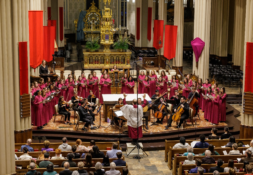Students reflect on difference between residential experiences
Dorm culture is crucial to Notre Dame life. It has a lasting impact on every student’s college experience due to the university’s three-year on-campus living requirement. The Irish Rover spoke with students to hear first-hand how dorm culture has affected their on-campus experience.
Though students held differing views of their dorm’s culture based on factors such as extra-curricular involvement and area of study, a trend emerged among respondents: the disparity between community bonds in men and women’s dorms. Particularly worrisome is the recent exodus of rectors from numerous dorms—most notably female dorms.
Residents of Farley Hall lived without a rector for the entirety of the fall semester, and Breen-Phillips Hall (BP) hired a new rector within the last year, after their previous rector began the spring 2023 semester taking a temporary leave of absence and never returned.
Unfortunately, many female dorms on campus have struggled to hold long-lasting rectors in recent years. Without the presence of a consistent rector, the needs of female dorms on campus are not being met.
When women on campus hear their rector is taking “a temporary leave of absence,” they no longer trust this to mean temporary. One resident of BP said, “I assume it means that they are never going to return to campus serving in the same capacity as a rector, and I become frustrated with the lack of transparency provided to the residents of that hall.”
When asked about his influence on dorm culture, Michael Davis, rector of Siegfried Hall, told the Rover, “The role of the rector in maintaining or changing the culture is one of trying as best as one can to have ‘an ear to the ground’ in being attentive, listening, and responding to the rumblings of the hall community and its needs.”
This instability within female dorm communities may be one reason for the noted lack of community bonding in comparison to men’s dorms. One female resident of Johnson Family Hall said, “Before coming to Notre Dame, I would hear about the dorm life and the traditions from my brother, who also attends Notre Dame. But once I arrived, I found myself in a rather different reality.”
Commenting on this difference, Jackie Nguyen, a sophomore in Lyons Hall, said, “I think female dorms struggle more with initial community building, but given the opportunity to learn each other’s hearts, the community truly shines in women’s dorms.”
Results from ND Day, a campus-wide club and dorm fundraising event, also reflect a difference in dorm experience. Every year, the top twenty-five groups form a leaderboard, but the rankings are not determined by the amount of money donated. Rather, they are determined by the amount of individual donors who gave to a particular group.
Last year, St. Edward’s topped the charts for dorms, raising $49,479 from 730 donors, the fourth best result for all campus clubs. Morrissey and Dillon trailed close behind in places 11 and 12 overall. Three more male dorms took places 14, 15, and 16. Lyons Hall was the first female dorm to make the leaderboard at 18 overall, raising $20,821 with 231 donors. The only other female dorm to make the top 25 was Cavanaugh Hall in twenty-third place, with 210 donors.
St. Edward’s, as well as the other male dorms included in this list, have been said to foster community to a greater degree than most female dorms. When asked what St. Edward’s means to him so far, freshman Joe Robuck, shared, “I entered Welcome Weekend feeling apprehensive and alone, and I left knowing that I’d not only found some of the most incredible friends imaginable, but that I’d do just about anything for Sted’s (e.g., shave a mullet into my head in January).”
The men of St. Edward’s have a yearly tradition of giving each other mullets as part of their Mullets Against Malaria fundraiser. Though female dorms also host signature fundraisers such as McGlinn Hall’s Casino Night or Ryan Hall’s Wheelchair Basketball tournament, “they do not feel as storied as the traditions of the male dorms, even though they garner high attendance,” according to one McGlinn senior.
Sophomore Maddie Colbert was not a huge fan of the mullet presence in North Dining Hall, but she commented that she can, nonetheless, “appreciate the culture.” Like Colbert, many women on campus are eager to have stronger dorm culture, but struggle to establish traditions within their dorms that cultivate it.
Nguyen suggested that dorm retreats can be a great avenue for allowing women to bond as a community: “On our Lyons retreat this weekend, girls stayed up late playing games, having fireside chats, and getting to know each other on a more intimate level, and I think everyone on the retreat came away with a new friend or with many new friends.”
Many echoed this sentiment that encouraging students to be more invested in their dorm communities is the path forward. Davis commented, “Investment in this community thereby furthers these bonds that can and often do sustain us through the occasionally turbulent and disorienting, yet also beautiful and exciting, years at Notre Dame and beyond.”
Bridgette Rodgers is a sophomore studying political science and theology. You can reach her at brodger4@nd.edu.
Photo Credit: Notre Dame Residential Life
Subscribe to the Irish Rover here.
Donate to the Irish Rover here.





